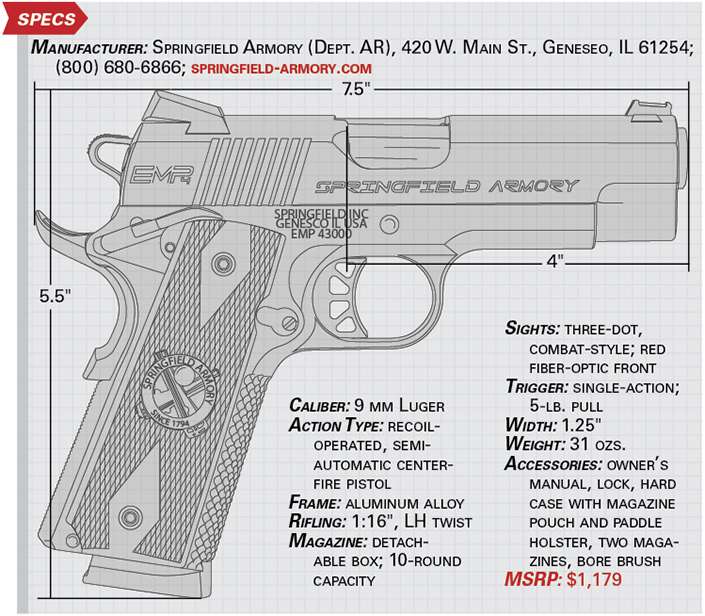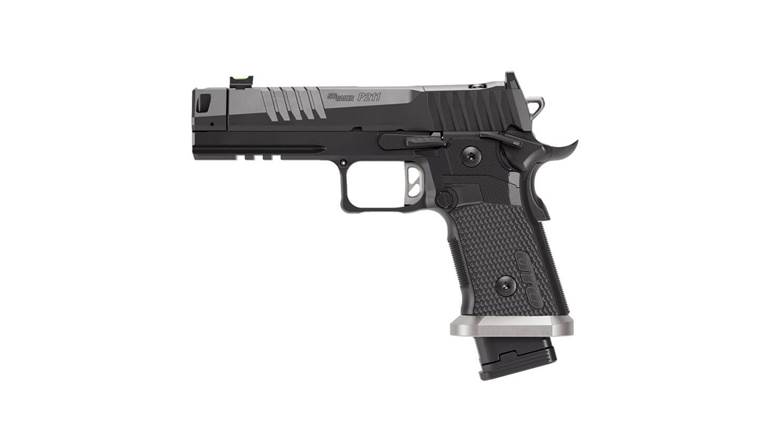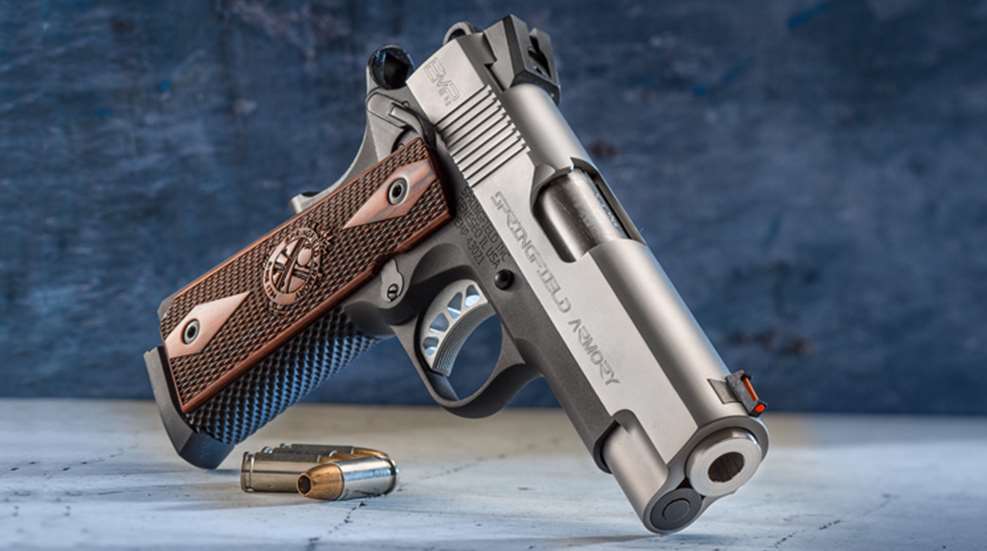
Every handgunner with significant time behind the sights understands certain truisms about the game: All real guns are made with blue steel and black walnut; no box-stock trigger (double-action or single-action) came close to that of a pre-war Smith & Wesson; and no wheelgun ever shot like a Python.
Please understand, of course, that I exaggerate for emphasis, but some of these oft-repeated mantras carry a sort of majestic certainty when repeated over the gunstore counter.
The belief that major modifications to the beloved M1911 pistol have run their course is another one. Anything else you might do to the grand old gun is just cosmetic, right? I might have agreed, but after a cautious survey of Springfield’s latest, I think that the Illinois gunmaker has come up with something unique. The gun is the EMP4, and it is a smaller rendering of the company’s Champion series of short-barrel, short-slide, Commander-size M1911 pistols. In this case, “smaller rendering” is a term that needs to be looked at more closely. In history, the M1911 was the same single-column, single-action, 39-oz. gun in .45 ACP from the time of its 1911 introduction until the late ’20s, when a second chambering—.38 Super—was introduced. That model was made on the same frame as the .45, as was the .22 Long Rifle ACE model of the 1930s. It was not until after World War II that we saw the original maker adapt the platform to a shorter, lighter and handier gun in 9 mm Luger, .38 Super and .45 ACP. Called the Commander, it was an instant hit. And as a size category of the M1911 platform, it still is.
After that, we entered a period that continues to the present, a time when the M1911 pistol was produced by a growing number of makers. In order to appeal to all sorts of shooters—military, police, defensive, competitive, outdoors and above all, concealed carry—the gun changed. It grew shorter for some uses and longer for others. Some M1911s became wider to accept double-stack magazines of greater capacity, and new chamberings appeared to fill one perceived need or another. But all of these many variations were based on a frame originally designed to handle the .45 ACP cartridge, which, at 1.275" in overall length, is relatively long. Remember, the cartridge has to fit into a sheet-steel box magazine, which itself has to fit into the grip area of the gun’s frame—quite a lot of material considering that the shooter’s hand must wrap around all of that and the stocks when grasping the gun. That was all fine for a gun originally designed for hard military service. But when chambered for the much shorter 9 mm Luger, some sort of spacer was required to fill the unused area in the front or rear of the magazine. In order to properly scale the platform to the 9 mm Luger cartridge, some material simply had to go.
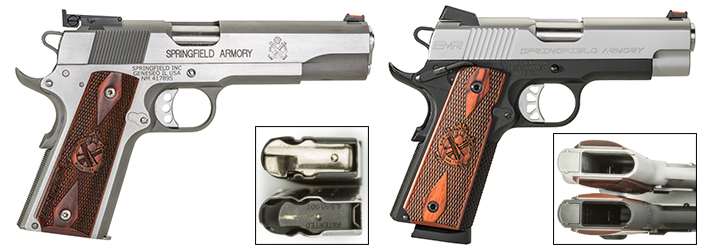
Until not too long ago, most of the many abbreviated variations of the M1911 pistol were designed by reducing the length of the barrel and slide area or by shortening the butt section. Such changes often amounted to little more than modifications to the basic platform, although it should be obvious that removing significant amounts of material in such a manner completely changed the character of the M1911 pistol. Still, to make an efficient M1911 chambered in 9 mm Luger that is no bigger than it needs to be, more conceptual engineering is required. That’s exactly what Springfield has done with the EMP4. As with the original, 3"-barreled EMP that came before it, the new model’s proportions eliminate unneeded frame material by taking a “slice,” as it were, right out of the middle of the gun’s grip area. Think of it by imagining a line drawn through the grip screws, then visualize about 1/8" of the gun being removed along that line from the top of the slide all the way down through the magazine well. Now you’ve got a visual on the newly optimized receiver that happens to be exactly the right size for a magazine proportionally appropriate in cross section for the 9 mm Luger cartridge. The original Enhanced Micro Pistol, at 5" in height and 6.6" in length, was almost as small as the currently popular M1911-format .380 ACPs. And while the new EMP4 version is somewhat taller, with a grip area that measures 5.5" high, and longer, with an additional inch of barrel, its overall length is only 7.5", or just 0.9" more than the original EMP. So, while it is a bit bigger than the original, it holds one more round of ammunition in its 10-round magazine, and, of course, its longer top end yields slightly more muzzle velocity and sight radius.
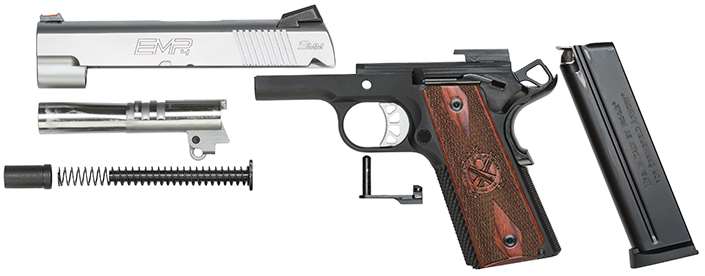
The result of all this selective size manipulation is a very sensible variation on the M1911 theme—one that is optimized for what is apparently America’s current favorite cartridge, the 9 mm Luger, and that will also be offered in .40 S&W. My sample gun was from the first batch made, and it’s a good-looking pistol. The attraction begins with a stainless steel upper in a sort of brushed silver finish that contrasts nicely with the aluminum alloy receiver, which is anodized in a matte black. Cocking serrations are angled in the modern style, and the so-called “Browning step” at the lower front corner of the slide is a bit more tightly radiused than most. The rear sight, with a modern, angled shape, has dots on either side of the notch and the front sighting element is a light-gathering, red fiber-optic pipe. Both sights are installed in machined dovetails in the slide.
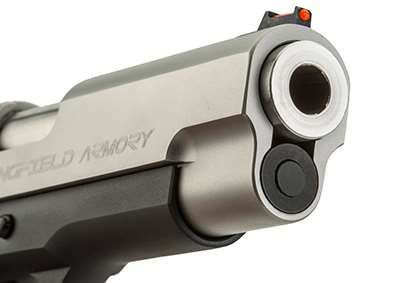
While most of the slide’s interior features are conventional, the 4" barrel is a bit different. It’s the type that dispenses with a separate bushing and accompanying recoil spring plug. This means that a full-length guide rod lies beneath it. Also, as is the case with other Springfield aluminum-frame M1911 pistols, the barrel features an integral feed ramp at its lower rear that fits into a corresponding recess in the frame. That way, bullets ride on the ramp’s steel surface as cartridges are fed into the chamber, rather than the comparatively softer aluminum frame, and there is no need to precisely blend separate barrel and ramp surfaces together as in most conventional M1911 designs.
Now, let’s take a look at that new magazine that is specifically designed to make this gun work with the 9 mm Luger cartridge. As noted elsewhere, it has different proportions than other M1911 magazines. The reduction in size is from front to back, which takes this dimension down to the point that the cartridge—shorter than the .45 ACP by 0.106", or a little more than a tenth of an inch—fits perfectly. The magazine is exactly the same height as that for the .45, and there’s no difference in dimension from side to side. But since 9 mm cartridges are approximately 0.085" smaller in diameter than .45 ACPs, Springfield formed internal ribs in the magazine’s walls that keep the cartridges aligned and help position them for efficient feeding. Three of the new 10-round magazines are provided with the EMP4, and they feature slam pads on their bases that actually cover the bottom end of the slightly protruding magazine.
To suggest that Springfield went to a bit of trouble in redesigning the EMP4’s internal parts in order to accommodate its proportional optimization would be a gross understatement. In fact, it had to redesign and manufacture 17 parts that are similar to, but differently dimensioned, than those found in a standard M1911. Most are along that imaginary line I mentioned already. Obviously, those such as the firing pin and firing pin spring, extractor, trigger and most others related to the gun’s lockwork are shorter. Suffice it to say that this pistol is still an M1911 in the handling sense, as well as in its assembly and disassembly. But its smaller proportions are noticeably different from those of a full-size M1911, and, for a huge portion of the shooting population, that represents a significant advantage—but more on that later.

For now, let’s look closely at the layout of the gun, which has the familiar controls in the traditional locations. For shooters who are left-handed, the bilateral safety means there’s also a paddle under the thumb on the receiver’s right. The slide lock and magazine catch are, of course, only on the left side, as on the original M1911. Stocks are a handsome reddish-brown laminated wood, checkered in the traditional double-diamond pattern and with the Ordnance Corps-inspired crossed cannon and flaming bomb logo. They are pretty slim, which is consistent with the obvious effort to appeal to the small-handed market. The mainspring housing is flat and checkered. There is a finishing touch in the EMP4’s frontstrap. In many high-end M1911 pistols, it is checkered in 20-, 25- or 30-line-per-inch traditional patterns, and, in recent years, some custom pistolsmiths have tried other designs to give the shooter a better gripping surface. The EMP4’s frontstrap surface is like that of a golf ball, an object about which I confess I know little. It appears to be applied with row after row of plunge cuts with a small ball-end mill. It looks cool and, more importantly, does the job of keeping the gun anchored in the hand very well.
I took the pistol to the range for a couple of sessions, which proved informative. Before I sat down at the bench for a serious accuracy evaluation, I mixed a variety of loads and ran them through the EMP4 to determine its reliability. Even with different bullet styles being fed out of the same magazine, the new Springfield ran with zero malfunctions. I fired the gun tilted 90 degrees right and left and upside down, and it still functioned fine. Shooting for accuracy, I had to rely on shooting from a sturdy bench and sandbags, as Ransom Rest inserts were not yet available. Using the typical American Rifleman protocol, I fired a series of five consecutive, five-shot groups with three different loads at 25 yds. and found the gun to group quite commendably. In fact, seldom do I see a new pistol perform so consistently. The average group size for each of the three loads was 2.48", 2.52" and 2.33", which is excellent accuracy.
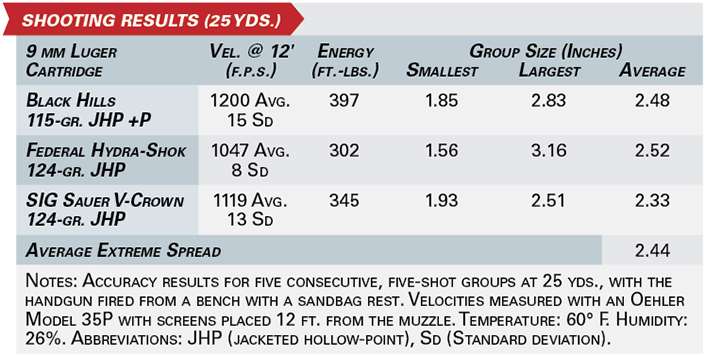
After stepping back from all the shooting and simply looking at the gun in my outstretched palm, I realized that, despite its high-quality manufacture, innovative engineering and excellent performance, the EMP4’s greatest virtue is its size. When I took it to the gunstore and asked rank-and-file shooters to check it out, most people’s first response was silence—because they couldn’t figure out what they were holding. It is obviously an M1911, but its size made it more comfortable than what most shooters are used to. Since many shooters have had problems trying to teach their wives or daughters the use of the M1911 pistol, this gun might really help. I don’t mean to imply that it is a “girl’s” gun, because there are a great many men who would also be better off with the EMP4.
In short, I believe the EMP4 is the first 9 mm Luger-chambered M1911 in decades that has been sized correctly for its cartridge.
